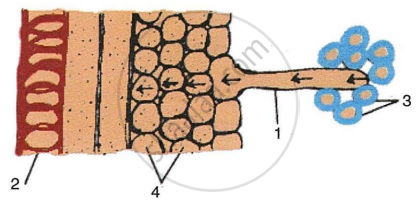Advertisements
Advertisements
Question
The diagram given below represents a plant cell after being placed in a strong sugar solution. Study the diagram and answer the questions that follow:

- What is the state of the cell shown in the diagram?
- Name the structure that acts as a selectively permeable membrane.
- Label the parts numbered 1 to 4 in the diagram.
- How can the above cell be brought back to its original condition? Mention the scientific term for the recovery of the cell.
- State any two features of the above plant cell which is not present in animal cells.
Solution
- Plasmolysed cell
- Cell membrane acts as a selectively permeable membrane.
- 1 – Cell wall, 2 – Space filled with strong sugar solution, 3 – Plasma membrane, 4 – Nucleus
- If the cell is placed in a hypotonic sugar solution, the cell will be brought to its original condition. This is called deplasmolysis.
- Features present in the plant cell which are not present in the animal cell:
- Presence of cell wall.
- Ability to shrink the protoplasm and plasmolyse.
APPEARS IN
RELATED QUESTIONS
Give scientific reasons : Balsam plants wilt during mid-day even if the soil is well watered.
What is the difference between ‘flaccid’ and ‘turgid’? Give one example of flaccid condition in plants.
Give suitable biological reasons for the following statement:
Root hairs become flaccid and droop when excess fertilizers are added to the moist soil around them.
Distinguish between the following:
Flaccid condition and turgid condition
Name the following:
The process by which wilting or drooping of leaves occurs.
Fill in the Blank
Wilting and drooping of leaves is due to loss of ________.
Excessive use of fertilisers in agricultural fields reduces the yield of crops. Justify the statement.
The hydrostatic pressure of the cell sap on the cell wall is called ______.
Addition of salt to pickles is a method of killing the bacteria by ______.
The figure given below is a diagrammatic representation of a part of the cross-section of the root in the root hair zone. Study the same and then answer the questions that follow:

- The parts labelled as 1, 2, 3 and 4 are:
- Root hair, Xylem vessel, Soil particles, Cortex respectively.
- Xylem vessel, Soil particles, Root hair, Cortex respectively.
- Root hair, Xylem vessel, Cortex, Soil particles respectively.
- Cortex, Soil particles, Xylem vessel, Root hair respectively.
- The process that enables the passage of water from soil into the root hair is:
- Diffusion
- Active transport
- Osmosis
- Passive absorption
- The kind of force which exists between a liquid and any surface is called as:
- Cohesive force
- Adhesive force
- Capillarity
- Suction force
- The kind of force between the same kind of liquid molecules is:
- Capillary force
- Transpirational pull
- Adhesive force
- Cohesive force
- Sometimes exudation of water occurs from the margin of the leaves in the early morning or night. It is termed as:
- Transpiration
- Guttation
- Bleeding
- Osmosis
